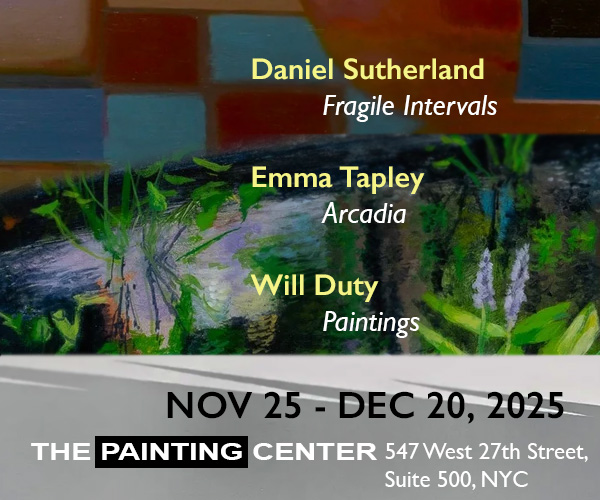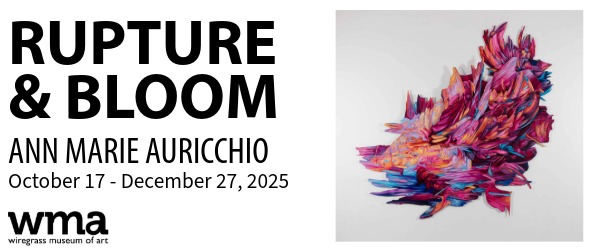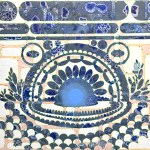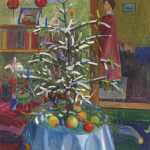Contributed by Sharon Butler / I took a trip to Madison, Wisconsin, in December, when the sky was gray but before the temperature had turned bitter. My guide was Leslie Smith III, a 2009 Yale MFA graduate with a BFA from the Maryland Institute College of Art who will have paintings on display at VOLTA next week with beta pictoris gallery / Maus Contemporary. Smith is an assistant professor of drawing and painting at University of Wisconsin-Madison, where he has a generous studio in the art building on campus. During my visit, he showed me his new paintings, which are purely abstract, comprising multi-panel shaped canvases, vivid, high-key color, and wobbly geometric shapes. We talked about the painting process, his shift to shaped canvases, and his transition from figurative work to abstraction.
Sharon Butler: Tell me a little about your background. When did you start painting?
Leslie Smith III: I grew up in Silver Spring, a Maryland suburb outside of Washington, DC. My father was a photographer for USA Today, and he loved the arts. He saw the world through his camera. He took one everywhere. He took my brother and me to the museums all the time, even though we didn’t know what we were looking at.
Art became serious for me at the Albert Einstein Visual Art Center where I attended high school painting was the best thing ever. One thing leads to another, and the next thing you know, you’re an artist! I went to MICA and studied primarily with Barry Nemett, Tony Shore, Michael Weiss, Christine Neil, and Raul Middleman I spent most of that time painting people.
I had two good years making paintings at Yale. I focused on how to make paintings self-subsisting entities–experienced on their own terms despite any aesthetic relationship to history or the projections of others. I wanted to know if it is possible for painting to validate itself by referencing itself? In doing so subsisting autonomously.
Afterwards, I began to realize that the presence of figuration was more important to me than an actual figure. Figures led to too many questions: Why are these figures black? Why are they white? I got tired of all the questions, constant scrutiny through the lens of race. People expected my work to have overt political content, and there was an expectation that I should be speaking about a black experience. I mean, I thought I was; just in my experience and as an abstractionist. So I got rid of everything that pigeonholed the work into any single category.
SB: And now, you are still working abstractly, but have begun using shaped canvases. How did that happen?
LS: This is one of the last pieces I made before I switched over to shaped canvases [he points to a rectangular canvas]. The shape in the middle is a window. I made a series of paintings based on a room flattening space, create an image that was also an abstraction. I was interested in a few different variables: a back wall, portal — some kind of light phenomenon. This one’s called Creeper. There’s a creepy figure responding to this De Chirico-esque nude, in front a pink digitized military fatigue. The more I made these paintings the more I cared about the recurring window shape, and I just decided to make a shaped canvas based on it. I made several in that rounded portal shape.
SB: What was it like working on shaped supports after working within a rectangle for so long?
LS: I started the first shaped piece in the summer of 2012. I didn’t know what I was doing! It was a challenge on every level. The figure-ground relationship became open-ended. All these seemingly new things were happening for me. The geometry of the shapes inside was becoming more complex, too, due to the influence of multi-dimensional geometry. I started trying to redefine “flatness,” to force post-painterly concepts into a painterly language.
SB: Can you talk a little more specifically about your relationship to post-painterly concepts?
LS: I’m in love with Color Field painting and Hard-edge abstraction, and I make paintings from a place where post-painterly methodologies embrace the nuances of lived experiences. At least that’s what I want them to do. So when I’m solving the problems that start my paintings I consider how the principles of expressionistic painting commingle with post-painterly methodologies in order to create a painting that is complex in its operation. I’m interested in painting allegorically, relating it to the complexities of how we coexist as individuals, each with deep-seated subjectivities. As a result my recent works are image-objects, that fluctuate between pictorial flatness and the illusion of perceptual dimensionality.
SB: You’re talking about the type of image you want to paint and the type of object you want to create. Flat image vs. something that appears to be three-dimensional vs. something that actually is three-dimensional.
LS: Yes: a recognizable flat shape vs. the illusion of space and atmosphere. For example, the color of a flat sheet of paper vs. the appearance of that same color when the paper is folded or rolled into a three-dimensional shape. In the old work I tried to keep the two types of shapes separate but the outcome always seemed predictable. Then I began thinking that the shapes could work together — and I started trying to create meaningful harmony. Now they aren’t combative — they are living together. And the outcome is much less predictable.
SB: Does that explain why you are drawn to imperfect shapes? Because imperfection is less predictable?
LS: This is a shape I’ve made a few times in different scales, and I’m beginning to realize that every shape has it’s own limitations. In this one, A Better Mouse Trap, I’m not creating a portal for someone to look into, It’s a shape that sits on the wall and has gravity and weight. It feels, in fact, misshapen. There’s a sense that maybe a better version of this shape exists out in the world. Maybe through some processes it ended up like this. When they are all seen together, the subtle shifts in each shape create narratives. So I think the crux of the shift came from introducing two canvases to each other. There are a thousand different ways to make a mark, and after you explore them all, you start to get bored. I think that’s why I began bringing the panels together. Putting one shaped canvas next to another creates a new kind of line. You need to create marks that feel real and authentic. Putting canvases together has so many possibilities. Creating something that’s sincere and honest and can be experienced in many ways without being vague or non-specific is important. I’m also interested in looking at one of these multi-panel paintings, and imagining the parts moving, I wonder if the lines and shapes would match up or be in different places if time was something to be considered?
SB: Tell me about your process. Do you make studies for the paintings?
LS: I used to work for Eric Fischl and he turned me on to this Kromekote paper. It’s industrial printing paper for offset lithography. Super shiny. When the oil hits the paper, it pools before the surface accepts the oil. It sits right on top of the paper. I don’t like dry color media and this paper gives me the immediacy that drawing has but with paint. My experiments on the Kromekote are like loose studies. They’re more expressive but they give me a chance to establish how I want my constructed forms to relate to each other in a larger, longer, sustained painting. In the studies I focus on the most important elements and flush them out.
SB: Whose work are you looking at these days?
LS: Most recently, Jack Tworkov. Super important. There is something great about the way he responds to humanist concerns with abstraction. Tworkov’s paintings in the late ’70s start looking futuristic. There’s a sleekness to them — to the ideas, the way he’s working with geometry. I saw a show of his work at Alexander Gray two or three months ago. I was blown away. I’m also looking at Jack Whitten and Stan Whitney in similar ways. Like all artists I feel like I’m stuck between all these things — knowing the difference between inspiration, content, and subject matter, understanding just what informs your work.
SB: And the gap between what you love and what you make.
LS: Yes. Exactly. And I love Jack Whitten’s processes, and I’m interested in Tworkov’s ideas involving geometry. I’m also looking forward to seeing Frank Stella’s show when I’m in New York.
SB: Stella’s work has more emotion than people give him credit for. They talk about his ego and his intellect — no one talks about the emotion in his work, but it’s overflowing with emotion.
LS: I agree. Trying to bring emotion into post-expressionist abstract painting seems to be a problem — the assumption is that emotion is conveyed through a gestural, painterly approach, and that’s not necessarily the case. I love this Stella quote from 1986 [pulls out a book and reads]: “What abstract painting can do better than anything else is evoke a sense of recognition, indefinite and yet ecstatic. At the same time, it’s getting to the emotional underpinning that we all share, that is a substitute for the common religious or social belief. I believe abstraction can get to that.” I totally believe this. In order for images to communicate, to be connected to social and cultural issues, you need to get your audience to dive into abstraction.
SB: A strange and mysterious thing takes place in the distance from an artist’s hand and heart to the canvas. It’s hard to talk about but it’s there. It’s hard to write about. But when you see really good work you know it has happened.
LS: That’s the thing. It doesn’t always happen. Sometimes I feel like I’m trying too hard to find it, to get at this thing. I understand the process is organic, but I’m always pushing. If I don’t, it’s like I’ll never get there.
“Leslie Smith III,” beta pictoris gallery / Maus Contemporary, VOLTA NY. Wednesday, March 2, 2016 through Sunday, March 6, 2016.
Related posts:
Studio visit: Hermine Ford’s order and disruption
Jack Whitten: Ready-nows
Picks from VOLTA NY, 2015
——
Two Coats of Paint is licensed under a Creative Commons Attribution – Noncommercial-No Derivative Works 3.0 United States License. To use content beyond the scope of this license, permission is required.
































It's great to hear a young artist speak so frankly about abstract painting that is accessible. Bravo.
Pingback: 2020’s grim atmosphere of loss: Shari Urquhart and others – The Lives of Artists